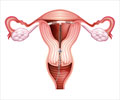Intrauterine devices that contain higher doses of copper are more effective in preventing pregnancy than IUDs with lower copper doses.
Intrauterine devices that contain higher doses of copper are more effective in preventing pregnancy than IUDs with lower copper doses, according to a new systematic review of studies.
In addition, increasing the copper content does not cause an increase in side effects prompting removal of the device, such as bleeding and pain, the review found.“In general, the comparative analyses suggest higher effectiveness and similar side effect profile with high-copper IUDs compared to low-copper ones,” concluded the review authors.
The review appears in the current issue of The Cochrane Library, a publication of The Cochrane Collaboration, an international organization that evaluates research in all aspects of health care. Systematic reviews draw evidence-based conclusions about medical practice after considering both the content and quality of existing trials on a topic.
The IUD is the most widely used reversible method of contraception in the world. Most IUDs consist of a plastic frame wrapped with copper wire, although the shape of the frame and the amount of copper wire vary among models.
The reviewers analyzed 34 randomized controlled trials that compared the effectiveness and side effects of different copper IUDs. More than 50,000 women from around the world were enrolled in these studies, which lasted from one year to 12 years.
Nine IUDs were included in the analysis. Most devices had a T-shaped or horseshoe-shaped design. The surface area of copper varied from 200 to 380 square millimeters.
Advertisement
The T380A, sold under the trade name ParaGard, is a T-shaped device that contains 380 square millimeters of copper, the highest dose of all IUDs included in this analysis. In direct comparisons, it performed as well as or better than both lower-dose T-shaped IUDs and horseshoe-shaped IUDs containing up to 375 square millimeters of copper.
Advertisement
“It is unlikely that new IUDs will be much more effective than TCu380A in short-term use,” the authors said. “Contending IUDs will need to be studied in large number over a long period of time.”
“Women in [the United States] who want long-term contraceptive protection are lucky that they have the best-performing copper IUD in the world,” said David Hubacher, Ph.D., senior epidemiologist at Family Health International.
The most common side effect leading to removal of the copper IUD is increased menstrual bleeding. In this review, IUDs with a higher copper dose had a slightly increased risk of discontinuation due to bleeding and other side effects during the first year, but rates of discontinuation were similar among all IUDs over longer follow-up periods.
The possible association between IUD use and pelvic inflammatory disease (PID) is another concern. However, according to data from World Health Organization trials, the primary risk of PID occurs within the first three weeks after IUD insertion and is low thereafter.
The risk of PID is also related to exposure to sexually transmitted diseases. IUD users who are at low risk of sexually transmitted diseases have little long-term risk of PID, even in the first month after insertion.
“If a woman is not at risk of a sexually transmitted infection, then her risk of developing PID that’s attributable to the IUD is practically nil,” Hubacher said.
Despite its safety and effectiveness, women in the United States are less likely than women in other countries to choose the IUD as their contraceptive method. In the 2002 National Survey of Family Growth, just 1.3 percent of American women ages 15 to 44 reported using an IUD.
China leads the world in IUD use, with more than a third of women using this form of contraception. European countries have rates of IUD use that are 3 to 16 times higher than in the United States.
Even within the United States, patterns of use vary widely. For example, female physicians in the United States use IUDs at rates between two and five times higher than among women in the general population, controlling for age and income.
“That is a very telling statistic,” says Hubacher. “Female physicians understand the IUD to be a method that is safe and effective, and they’re using it because they have the knowledge.”
(Source: Newswise)











